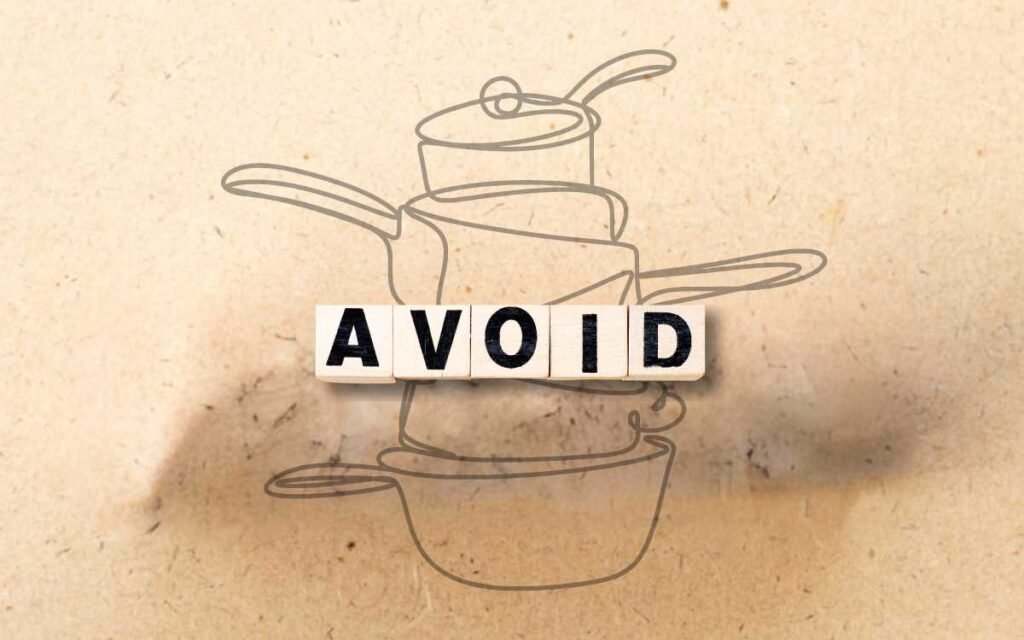
- Introduction
- How to Choose Environmentally Friendly Pots and Pans
- Top 4 Brands of Eco-Friendly Pots and Pans
- Is Ceramic or Stainless Steel Better for the Environment?
- What to Strictly Avoid When Buying Pots and Pans
- When to Throw Out Your Eco-Friendly Pots and Pans
- Understanding Certification and Labels
- The Future of Eco-Friendly Cookware
- Bottom Line
- FAQ's
Introduction
In our quest for greener living, every small step counts, including our choices in the kitchen. Environmentally friendly pots and pans are becoming a popular choice for eco-conscious cooks. They not only help reduce your carbon footprint but also promote healthier cooking.
Let’s dive into how to choose the best eco-friendly cookware, top brands to consider, and other important factors.
How to Choose Environmentally Friendly Pots and Pans

Choosing eco-friendly pots and pans involves considering the materials used. Also, the making and the longevity of the product. Here’s what to look for:
Materials
Opt for recycled or sustainable materials like stainless steel, cast iron, or ceramics. These materials are not only durable but also eco-friendly in various ways:
- Stainless Steel: It is often made from a lot of recycled materials. It is highly durable and recyclable at the end of its life. Its longevity means it doesn’t need to be replaced frequently, reducing waste.
- Cast Iron: This material is incredibly durable and can last for generations if properly cared for. Cast iron cookware is also recyclable and retains heat well, making it energy-efficient.
- Ceramics: Made from natural materials, ceramic cookware is non-toxic and safe for cooking. It’s also energy-efficient because it retains heat well, reducing cooking time and energy use.
Non-toxic Coatings
Ensure the cookware is free from harmful chemicals like PFOA, PTFE, and heavy metals. These substances can leach into your food and are harmful to both your health and the environment. Instead, look for coatings that are:
- Thermolon: A ceramic-based non-stick coating that is free from PFAS, PFOA, lead, and cadmium.
- Enameled: Enameled cast iron is a great option as it is non-reactive, non-stick, and doesn’t contain harmful chemicals.
Durability
High-quality, long-lasting cookware reduces waste by eliminating the need for frequent replacements. When choosing cookware, consider:
- Build Quality: Look for robust construction and materials known for their longevity. For example, cast iron and high-quality stainless steel are known for their durability.
- Maintenance: Consider how easy the cookware is to maintain. Cookware that is easy to clean and resistant to scratches and wear will last longer.
Energy Efficiency
Some cookware heats up faster, reducing energy consumption. Look for:
- Heat retention: It is good in materials like cast iron and ceramics. They let you cook at lower temperatures and for shorter periods, saving energy.
- Good heating: Cookware that spreads heat evenly can prevent hot spots. It also cooks food faster, saving energy.
By considering these factors, you can choose pots and pans that are not only good for your kitchen but also for the planet. Buying eco-friendly cookware is a step toward sustainable living. It also helps with healthier cooking.
Top 4 Brands of Eco-Friendly Pots and Pans

Several brands stand out for their commitment to sustainability and high-quality products:
1. GreenPan

GreenPan is famous for its Thermolon ceramic non-stick coating, which is free from PFAS, PFOA, lead, and cadmium. These harmful chemicals can leach into your food and harm the environment.
GreenPan’s products use upcycled stainless steel and aluminum. This shows their commitment to eco-friendly manufacturing.
The advanced Thermolon coating is durable and scratch resistant. It makes cooking healthier and more efficient.
Pros:
- Reduces exposure to harmful chemicals.
- Durable and scratch-resistant.
Cons:
- Higher price point for advanced collections.
Visit GreenPan’s website for more details.
2. Made In

Made In offers stainless steel and carbon steel cookware. It is known for durability and eco-friendly manufacturing. They source materials responsibly, ensuring high quality and reduced environmental impact.
Made In focuses on creating long-lasting products, minimizing the need for frequent replacements. This commitment extends to their packaging. It makes them a great choice for sustainable cooks.
Pros:
- High-quality, durable materials.
- Eco-friendly packaging and production.
Cons:
- Can be pricier than some other brands.
Explore more on Made In’s website.
3. Great Jones

Great Jones combines style and functionality with a strong emphasis on sustainability. Their product range includes enameled cast iron and stainless steel cookware. They use good materials. This ensures durability and longevity, cutting the need for frequent replacements.
The company promotes sustainable practices. They use recycled materials and do responsible manufacturing. This makes their cookware practical and eco-friendly.
Pros:
- Stylish and functional designs.
- Commitment to using recycled materials.
Cons:
- May not be as affordable as some other brands.
Check out their offerings at Great Jones.
4. Xtrema

Xtrema specializes in 100% ceramic cookware that is non-toxic and safe for the environment. Most cookware has harmful chemicals and metals. Xtrema products are free from them.
So, they are a healthier choice. The company focuses on sustainable manufacturing, ensuring their products are made responsibly.
Xtrema’s commitment to non-toxic, eco-friendly products makes them a leader in green cookware.
Pros:
- Non-toxic and free from harmful chemicals.
- Environmentally friendly production.
Cons:
- Ceramic cookware can be more fragile than metal alternatives.
Discover more about Xtrema at Xtrema’s website.
Is Ceramic or Stainless Steel Better for the Environment?

Both ceramic and stainless steel cookware help the environment. But, they have traits that suit different preferences and needs:
Ceramic Cookware
- Materials and Safety: Ceramic cookware is made from clay and minerals. This makes it non-toxic and safe for cooking. It does not release harmful chemicals into food, providing peace of mind for health-conscious consumers.
- Energy Efficiency: Ceramic is known for its excellent heat retention properties. It distributes heat evenly and retains it well, which can reduce cooking time and energy consumption. This efficiency can lower overall energy usage in the kitchen.
- Ceramic is durable if handled with care. But, it can crack or chip if dropped or mishandled. Proper maintenance and handling are essential to prolong its lifespan.
Stainless Steel Cookware
- Materials and Safety: Stainless steel cookware is very durable. It resists corrosion, stains, and rust. It can withstand high temperatures and is less prone to physical damage compared to ceramic. This durability often translates to a longer lifespan for the cookware.
- Energy Efficiency: Stainless steel products have environmental benefits. They are often made from recycled materials, like scrap metals which reduces the need for new raw materials. It boosts recycling. This helps the environment.
- Stainless steel cookware is versatile. It works for many cooking methods, like searing, sautéing, and boiling. Its ability to handle high heat makes it suitable for both stovetop and oven use.
Choosing the Best Option
- Decide between ceramic and stainless steel cookware. Consider your cooking habits, lifestyle, and the environment.
- For Energy Efficiency: If you want to reduce energy use when cooking, ceramic cookware’s heat retention may help.
- For Durability and Longevity: Stainless steel cookware lasts longer. It is less prone to damage. This makes it a practical choice for those seeking durable kitchen investments.
- Environmental Impact: Both materials have eco-friendly attributes. Ceramic is natural and non-toxic. Stainless steel is recyclable and often made from recycled materials.
In conclusion, both ceramic and stainless steel cookware can be eco-friendly. Which is best depends on your needs and priorities. You may prioritize energy efficiency, durability, or sustainability. Both materials have clear benefits. They contribute to a greener kitchen and lifestyle.
What to Strictly Avoid When Buying Pots and Pans

When you’re shopping for eco-friendly cookware, it’s important to make choices that are good for your health and the environment. Here we have enlisted some key things to avoid:
Non-stick Coatings
Steer clear of cookware with non-stick coatings that contain chemicals like PFOA and PTFE. These substances can release harmful fumes when heated and stick around in the environment for a long time. Instead, look for safer cookware. It uses ceramic coatings or newer non-stick options. These options are free of PFOA and PTFE.
Short Lifespan Products
Try to avoid cheap cookware that needs frequent replacement. These products not only cost you more in the long run but also contribute to landfill waste. Invest in high-quality cookware. It should be made from durable materials like stainless steel, cast iron, or quality ceramics. These materials can last for years with proper care, making them better for your wallet and the planet.
Plastic Handles
Opt for pots and pans with handles made from metal or wood rather than plastic. Plastic handles can break easily and aren’t as heat-resistant. Plus, plastic is derived from non-renewable resources and can be difficult to recycle. Choosing handles made from natural or recyclable materials reduces your plastic use. It also helps the environment.
Additional Tips
- Packaging: Look for cookware with minimal or recyclable packaging to reduce waste.
- Manufacturing Practices: Check out the brand’s commitment to sustainability and responsible manufacturing. Certifications or statements about eco-friendly practices can guide your decision.
- End-of-Life Disposal: Consider how you’ll dispose of the cookware once it’s no longer usable. Opt for materials that are recyclable or biodegradable whenever possible.
Be mindful of these factors when choosing your pots and pans. They can make your kitchen safer and more enjoyable to cook in. They can also make it more environmentally friendly. Making these small changes adds up to a big impact on your eco-footprint while improving your cooking experience.
When to Throw Out Your Eco-Friendly Pots and Pans

Knowing when to replace your eco-friendly pots and pans is key. It is important for both safety and cooking well. Here are the key indicators that it’s time to consider getting new cookware:
- Severe scratches or chips: Deep scratches or chips in the cooking surface can harbor bacteria and compromise food safety. For non-stick and ceramic cookware, these imperfections can also cause harmful substances to leach into food.
- Warped or misshapen: Cookware that is warped or misshapen does not heat evenly, which can lead to uneven cooking results. This can affect the quality of your meals and pose safety hazards, especially when cooking at high temperatures.
- Peeling or flaking coating: In non-stick cookware, if the coating begins to peel or flake off, it’s crucial to replace it immediately. Peeling coatings can release toxic chemicals into your food, posing health risks if ingested.
- Handles: If handles become loose, cracked, or damaged, it can compromise the safety and usability of the cookware. Replace cookware with damaged handles to prevent accidents during cooking.
- Burnt or stuck-on residue is a sign of deteriorating non-stick properties or surface damage. You can’t clean it off, so you need to replace the cookware.
- Signs of rust: Stainless steel cookware should not rust under normal use. If you notice rust spots developing, it indicates a breakdown in the material’s integrity and may compromise food safety.
Understanding Certification and Labels

Look for certifications that indicate the cookware meets environmental and safety standards:
- FDA-approved: Ensures the materials are safe for food contact. This certification indicates that the cookware is free from harmful substances and safe to use.
- LFGB-certified: German standard for safety and quality. LFGB certification means the cookware has passed rigorous tests for safety, ensuring it’s free from harmful chemicals.
- Eco-labels: Indicates the product has met specific environmental criteria. Eco-labels can include certifications like Green Seal or the EU Ecolabel. They show that the product is eco-friendly and sustainably made.
The Future of Eco-Friendly Cookware

The future of eco-friendly cookware looks promising. Ongoing innovations aim to reduce its environmental impact. Emerging trends include:
- Recycled materials: More brands are using recycled metals and other materials. This reduces the demand for new raw materials and lowers the environmental footprint of manufacturing.
- Biodegradable cookware: Development of pots and pans that break down naturally at the end of their life cycle. These products are designed to minimize waste and reduce the burden on landfills.
- Energy-efficient designs: Innovations that reduce cooking time and energy usage. They are developing new designs and materials to improve heat distribution. This will help retain heat, making cooking more efficient and eco-friendly.
Bottom Line
As we look ahead, eco-friendly cookware is set to play a significant role in sustainable living. Materials are recycled. Options are biodegradable. Designs save energy. They are on the rise. Consumers have more choices than ever to make their kitchens green.
By supporting these innovations, you can help the planet. You can also enjoy the benefits of modern, sustainable cookware in your home.






